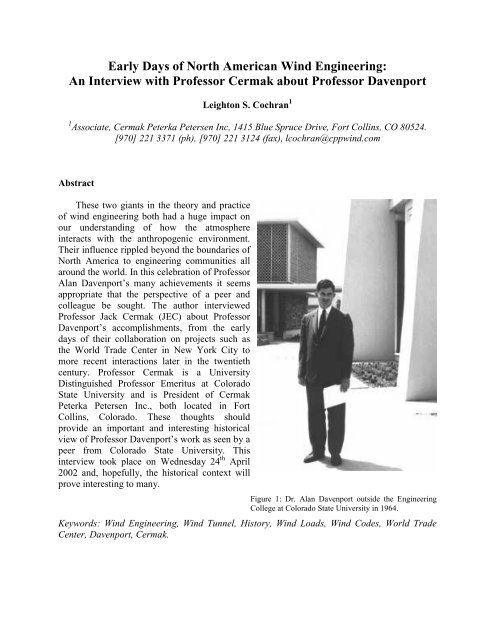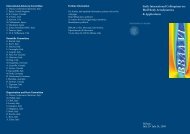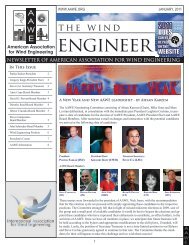An Interview with Professor Cermak about Professor Davenport
An Interview with Professor Cermak about Professor Davenport
An Interview with Professor Cermak about Professor Davenport
You also want an ePaper? Increase the reach of your titles
YUMPU automatically turns print PDFs into web optimized ePapers that Google loves.
Early Days of North American Wind Engineering:<br />
<strong>An</strong> <strong>Interview</strong> <strong>with</strong> <strong>Professor</strong> <strong>Cermak</strong> <strong>about</strong> <strong>Professor</strong> <strong>Davenport</strong><br />
Leighton S. Cochran 1<br />
1 Associate, <strong>Cermak</strong> Peterka Petersen Inc, 1415 Blue Spruce Drive, Fort Collins, CO 80524.<br />
[970] 221 3371 (ph), [970] 221 3124 (fax), lcochran@cppwind.com<br />
Abstract<br />
These two giants in the theory and practice<br />
of wind engineering both had a huge impact on<br />
our understanding of how the atmosphere<br />
interacts <strong>with</strong> the anthropogenic environment.<br />
Their influence rippled beyond the boundaries of<br />
North America to engineering communities all<br />
around the world. In this celebration of <strong>Professor</strong><br />
Alan <strong>Davenport</strong>’s many achievements it seems<br />
appropriate that the perspective of a peer and<br />
colleague be sought. The author interviewed<br />
<strong>Professor</strong> Jack <strong>Cermak</strong> (JEC) <strong>about</strong> <strong>Professor</strong><br />
<strong>Davenport</strong>’s accomplishments, from the early<br />
days of their collaboration on projects such as<br />
the World Trade Center in New York City to<br />
more recent interactions later in the twentieth<br />
century. <strong>Professor</strong> <strong>Cermak</strong> is a University<br />
Distinguished <strong>Professor</strong> Emeritus at Colorado<br />
State University and is President of <strong>Cermak</strong><br />
Peterka Petersen Inc., both located in Fort<br />
Collins, Colorado. These thoughts should<br />
provide an important and interesting historical<br />
view of <strong>Professor</strong> <strong>Davenport</strong>’s work as seen by a<br />
peer from Colorado State University. This<br />
interview took place on Wednesday 24 th April<br />
2002 and, hopefully, the historical context will<br />
prove interesting to many.<br />
Figure 1: Dr. Alan <strong>Davenport</strong> outside the Engineering<br />
College at Colorado State University in 1964.<br />
Keywords: Wind Engineering, Wind Tunnel, History, Wind Loads, Wind Codes, World Trade<br />
Center, <strong>Davenport</strong>, <strong>Cermak</strong>.
1. Introduction<br />
JEC: “I am saddened by not being able to participate in this symposium to honor <strong>Professor</strong><br />
<strong>Davenport</strong> for his monumental contributions and meet <strong>with</strong> our wind-engineering family.<br />
Unfortunately, the needs of my immediate family require that I give first priority to taking care<br />
of matters at home. Through many interactions, my respect and admiration for Alan as a teacher,<br />
researcher and engineer have grown continuously and I congratulate him for his pioneering<br />
accomplishments. His contributions to wind engineering have been significant, and have<br />
influenced many aspects of my research and practice. This interview gives me an opportunity to<br />
comment on the influence <strong>Professor</strong> <strong>Davenport</strong> and his colleagues have had on the early<br />
development of wind engineering. I am grateful to Dr. Leighton Cochran for suggesting and<br />
implementing this opportunity to review some of the pursuits on which I have had the pleasure to<br />
collaborate <strong>with</strong> Alan.”<br />
Figure 2: Drs. <strong>Davenport</strong> and <strong>Cermak</strong> <strong>with</strong> the aeroelastic models of the Word Trade Center in the Meteorological<br />
Wind Tunnel at Colorado State University in 1964.
2. <strong>Interview</strong><br />
LSC: “What are your earliest memories of meeting <strong>Professor</strong> <strong>Davenport</strong> and when was<br />
that?”<br />
JEC: “My first meeting <strong>with</strong> <strong>Professor</strong> <strong>Davenport</strong> was <strong>about</strong> 38 years ago and it happened<br />
on March 10, 1964 in my office at Colorado State University. The occasion was a visit by Alan<br />
<strong>Davenport</strong> and Les Robertson to discuss the capabilities of our newly constructed meteorological<br />
wind tunnel for modeling natural winds. They were developing a building project—the New<br />
York World Trade Center Towers—that needed wind-tunnel testing and they were in search of a<br />
proper wind tunnel to conduct the study. As a matter of fact, this meeting brought <strong>about</strong> a<br />
convergence of two major engineering advancements. One advancement was the design and<br />
construction in 1963 of a unique meteorological wind tunnel at Colorado State University that<br />
had the capability of creating turbulent boundary layers in the 100-ft (30-m) long section similar<br />
to full-scale atmospheric boundary layers. The second major advancement was innovative<br />
structural concepts that made design of the 1368-ft (417-m) tall New York World Trade Center<br />
Towers possible. These two advancements coalesced to initiate the common practice of windtunnel<br />
testing to determine wind loads, pressures and dynamic responses for structures.”<br />
Figure 3: The 1:500 World Trade Center models in the Meteorological Wind Tunnel at CSU in 1964.<br />
LSC: “Were your research interests at that time closely related or did you both merge from<br />
different directions to the area that became known as wind engineering?”<br />
JEC: “We had some interests in common and others that were somewhat different. <strong>Professor</strong><br />
<strong>Davenport</strong>, at that particular time in 1964, had developed major interests and writings on<br />
probabilistic concepts <strong>with</strong> his applications and interest being wind effects on structures.<br />
Whereas my interests were focused on basic fluid mechanics of turbulent boundary layers,<br />
diffusion and how one could actually simulate their atmospheric counterpart in the laboratory.<br />
My research in these areas began in 1950 and resulted in realization of the meteorological<br />
(boundary-layer) wind tunnel in 1963 at Colorado State University. This was followed by a
Figure 4: The World Trade Center team from left to right - A.G. <strong>Davenport</strong>, M. Yamasaki, M. Levy, J. Skilling, J.E.<br />
<strong>Cermak</strong> and L.E. Robertson.
oundary-layer wind tunnel, which was designed by Alan and constructed at the University of<br />
Western Ontario in 1965. The demand for wind-tunnel testing and research grew rapidly during<br />
the next two decades, <strong>with</strong> the result that a second boundary-layer wind tunnel was constructed<br />
at UWO in 1984. Mergence of our interests established what we now consider to be the key<br />
component of wind engineering—wind-tunnel simulation of wind loading on structures and<br />
dispersion of air pollutants. It should be noted that the wind-engineering discipline per se hadn’t<br />
been designated as such until 1970 when a meeting on wind loads on structures was organized at<br />
Cal Tech by <strong>An</strong>atol Roshko. That meeting resulted in the organization of the Wind Engineering<br />
Research Council, where Alan and I have been active participants for many years. Going back a<br />
bit further in time, we took some cues from work done at the National Physical Laboratory in<br />
England under the leadership of Kit Scruton. I think we all recognize Kit as a pioneer of wind<br />
engineering which, at the time, was called industrial aerodynamics.”<br />
Figure 5: A World Trade Center design team visit to the Engineering College at Colorado State University in 1964.<br />
From the top left those present are - R. Marshall, R. Grau, E. Plate, H. Tieleman, M. Levy, J. <strong>Cermak</strong>, M. Yamasaki,<br />
J. Skilling, L. Robertson, A. <strong>Davenport</strong> and R. Feld.<br />
LSC: “In what ways did you and <strong>Professor</strong> Alan <strong>Davenport</strong> collaborate in the past?”<br />
JEC: “I had the pleasure of collaborating <strong>with</strong> <strong>Professor</strong> <strong>Davenport</strong> on wind-tunnel studies<br />
for the New York World Trade Center Towers. That was our first collaboration which took place<br />
during the period of <strong>about</strong> March 1964 through October 1964. During that time Alan and Les<br />
traveled to our Fluid Dynamics and Diffusion Laboratory at Fort Collins <strong>about</strong> once a week.<br />
During those times we reviewed data acquired during the week on the aerodynamic responses<br />
and wind loads for the towers. Plans were then made for the next set of tests. We have<br />
collaborated on numerous other wind-engineering related undertakings. One that I enjoyed very<br />
much was co-authoring <strong>with</strong> Alan the manual “Design Windloads for Buildings and Boundarylayer<br />
Wind-tunnel Testing” for the Aluminum Architectural Manufacturers Association in 1985<br />
[1]. In 1993, Alan <strong>Davenport</strong>, Erich J. Plate (Universität Karlsruhe, Germany), Domingos X.
Viegas (University of Coimbra, Portugal) and myself organized a NATO scientific institute,<br />
which resulted in the publication “Wind Climate in Cities.” This was published by Kluwer<br />
Academic Publishers as NATO Advanced Science Institute Series E, Volume 277 and provides a<br />
wealth of information on the flow and dispersion in urban areas [2]. Then in 1999 we worked<br />
together on a committee of the National Research Council to prepare a report “Review of the<br />
Needs for a Large Scale Test Facility for the Research on the Effects of Extreme Winds on<br />
Structures.” [3]. <strong>An</strong>other undertaking in which Alan and I (and many others) have contributed is<br />
preparation of the American Society of Civil Engineers Manual of Practice No. 67 entitled<br />
“Wind Tunnel Studies, of Buildings and Structures.” The second edition was published in 1999<br />
[4]. These are a few specific activities where we have collaborated. Many other committees and<br />
activities of the American Society of Civil Engineers, the National Academy of Engineering and<br />
the Natural Sciences, the Engineering Research Council of Canada and national and international<br />
wind-engineering conferences have brought Alan and I together frequently during the last 38<br />
years. Every occasion has been a great pleasure as well as one of enlightenment.”<br />
LSC: “In your opinion, what were the most pivotal papers written by <strong>Professor</strong> <strong>Davenport</strong>?”<br />
JEC: “I believe the early papers set the stage for wind-engineering development during the<br />
last 40 years and in my mind are his most significant papers. The 1960 paper, “Rationale for<br />
Determining Design Wind Velocities” that was published in the ASCE Journal of Structural<br />
Engineering, Volume 86, is a time-tested contribution [5]. Some results of that continue to be<br />
found in building standards. Specification of exponents for power-law distribution of mean wind<br />
speed as a function of surface roughness made it possible to relate wind characteristics upwind of<br />
a particular building site to what should be modeled in the wind tunnel. In 1961, Alan wrote a<br />
paper “The Spectrum of Horizontal Gustiness Near Ground in High Winds,” which was<br />
published in the Quarterly Journal of the Royal Meteorological Society, Volume 87 [6]. Material<br />
presented in this paper is quoted in most of the research projects relating to wind loading on<br />
structures and in building standards. Probably the most influential contribution was the 1961<br />
paper, “Application of Statistical Concepts to the Wind Loading of Structures,” which is<br />
available in Volume 19 of Proceedings of the Institution of Civil Engineers [7]. This paper<br />
introduced the proper way to quantify wind characteristics and wind effects on structures. I<br />
believe these three papers provided essential foundations on which to build the wind-engineering<br />
discipline.”<br />
LSC: “Lastly, I was just wondering what, in your opinion, were <strong>Professor</strong> <strong>Davenport</strong>’s<br />
major contributions to code development?”<br />
JEC: “<strong>Professor</strong> <strong>Davenport</strong> has made significant contributions to building codes and<br />
standards in many countries - including Canada, United States, and England. A very important<br />
contribution to codes and standards has been criteria for the wind profile dependence on surface<br />
roughness. The latest contribution by <strong>Professor</strong> <strong>Davenport</strong> and his colleagues has resulted from<br />
pressures measured simultaneously at a large number of points on low-rise buildings [8 and 9].<br />
These data have resulted in windload criteria that now appear in the ASCE 7 standard [10].”<br />
3. Concluding Thoughts<br />
JEC: “I vividly remember that on many occasions Alan spoke <strong>about</strong> a chain of elements that<br />
must be considered in the process of designing a structure for wind effects. He always stressed<br />
that specification of wind characteristics is the weakest link in the chain. I would like to consider
a different chain—a chain of contribution to development of wind engineering. In this chain,<br />
Alan is definitely the strongest link.<br />
Acknowledgements<br />
The author would like to thank <strong>Professor</strong> Jack <strong>Cermak</strong> for his time and recollections that<br />
constitute the essential content of this paper. In addition the effort of Ms. Gloria Garza in finding<br />
all the photographs shown here is greatly appreciated.<br />
References<br />
[1] <strong>Davenport</strong>, A.G. and <strong>Cermak</strong>, J.E., “Design Wind Loads for Buildings and Boundary Layer<br />
Wind Tunnel Testing”, Aluminium Architectural Manufactures Association, 36 pages, 1985.<br />
[2] <strong>Davenport</strong>, A.G., Plate, E. J., Viegas, D. X. and <strong>Cermak</strong>, J.E., “Wind Climate in Cities”,<br />
NATO Advanced Science Institute Series E, Volume 277, Kluwer Academic Press, 772 pages,<br />
1993.<br />
[3] National Research Council, “Review of the Needs for a Large Scale Test Facility on the<br />
Effects of Extreme Winds on Structures”, 40 pages, 1999.<br />
[4] American Society of Civil Engineers, “Manual of Practice for Wind Tunnel Studies of<br />
Buildings and Structures - Number 67”, Aerospace Division, 214 pages, 1999.<br />
[5] <strong>Davenport</strong>, A.G., “Rationale for Determining Design Wind Velocities”, Proceedings of the<br />
American Society of Civil Engineers, Journal of the Structural Division, Volume 86, pages 39-<br />
68, 1960.<br />
[6] <strong>Davenport</strong>, A.G., “The Spectrum and Horizontal Gustiness Near the Ground in High Winds”,<br />
Quarterly Journal of the Royal Meteorological Society, Volume 87, pages 194-221, 1961.<br />
[7] <strong>Davenport</strong>, A.G., “The Application of Statistical Concepts to the Wind Loading of<br />
Structures”, Proceedings of the Institution of Civil Engineers, Volume 19, pages 449-472, 1961.<br />
[8] <strong>Davenport</strong>, A.G., Surry, D. and Stathopoulos, T., “Wind Loads on Low Rise Buildings: Final<br />
Report of Phases I”, Boundary-Layer Wind Tunnel report number BLWT-SS4-1977, University<br />
of Western Ontario, 1977.<br />
[9] <strong>Davenport</strong>, A.G., Surry, D. and Stathopoulos, T., “Wind Loads on Low Rise Buildings: Final<br />
Report of Phases II”, Boundary-Layer Wind Tunnel report number BLWT-SS8-1978, University<br />
of Western Ontario, 1978.<br />
[10] American Society of Civil Engineers, "Minimum Design Loads for Buildings and Other<br />
Structures", ASCE 7-98, 330 pages, 2000.





